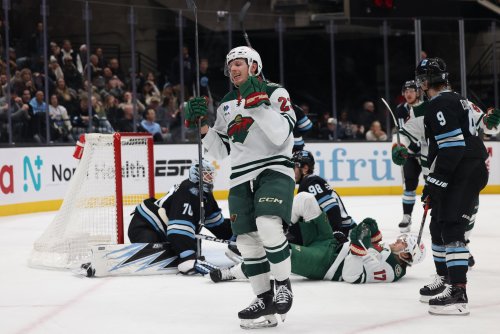
I said the other day, I'm probably the only person who hates feet. Not because they're gross but because they're complicated. Then I realized there are worse joint structures to write about and recanted that. You don't see these pieces often from me (because I'm not about to tempt fate), but when you do, there's usually a reason.
We've had a run on fractures amongst the Wild. Zach Parise and Jared Spurgeon are out with broken feet, and Mikko Koivu was taken out on Saturday with a fractured ankle. So, I'm going to talk feet, a little bit about ankles, and a lot on the fracture and recovery process.
Your foot has 26 bones. Those bones are structured, along with tendons and ligaments, to support your weight during standing and movement. The bones of the foot have three main groupings: tarsals, metatarsals, and phalanges. Your foot can also be divided into three parts: the hindfoot (2 of the tarsal bones: the talus, and the calcaneus), the midfoot (remainder of the tarsals), and the forefoot (metatarsals and phalanges).
The Calcaneus is the largest tarsal and helps you flex your foot and push off when you walk. The talus is located above it and articulates with the tibia, fibula, calcaneus, and navicular. This is the hindfoot.
Going to the midfoot, there is the cuboid bone. It is on the lateral side of the foot, ahead of the calcaneus but behind the the fourth and fifth metatarsals. The navicular bone is towards the middle of the foot, between the talus and the three cuneiform bones. The cuneiforms start on the medial edge of the foot and work inward and are called medial, middle and lateral cuneiforms.
Moving to the forefoot, you first have the metatarsals. They are numbered 1-5, going from medial to lateral. Each metatarsal has a head, neck, shaft, and base. Each metatarsal connects with one or more of the tarsals and one of the first row of the phalanges. You have similar structures in your hands called metacarpals. The phalanges in your feet are similar to the phalanges in your hand. However, feet phalanges are smaller. You have two phalanges in the great toe and three in all other toes.
The ankle is made up of two joints. There is the true ankle joint and the subtalar joint. The true ankle joint is responsible for up and down motion. It consists of the tibia, the fibula, and the talus. The subtalar joint allows the ankle to move from side to side. This joint consists of the talus and the calcaneus, which we also discussed as being part of the hindfoot.
A fracture or a break are basically the same thing. The bone's structural integrity has been damaged. Foot fractures can occur suddenly or over time, as in a stress fracture. Foot fractures occur for 10% of all the broken bones in the body. Injuries to the midfoot typically occur as a result of a direct blow (i.e. blocking a shot). The most common causes of foot injuries are falls, impacts from heavy objects (crush injuries), and stress/overuse injuries. For ankle fractures, causes include twisting or rolling the ankle, falling, or impact.
The number one symptom for both is, obviously, pain. There will be difficulty weightbearing on the foot or ankle (limping or not being able to walk at all). Swelling, bruising and tenderness are other key indicators. Depending on the degree of the fractures, deformity may be present. If deformity is present, medical attention is required because you run the risk of having a closed fracture break through the skin and become an open fracture. Nobody wants an open fracture and external fixation.
Physical examination and X-Rays are performed. MRIs and CT scans can be done if indicated. Then the course of treatment is determined. Treatment depends on the degree and complexity of fractures. For a toe fracture, nothing may be done. For a simple foot fracture, it may be wrapped or a post surgical shoe may be used. If it's more complicated, casting may be done. Surgery may be required, especially if the fracture is displaced. Ankle fractures may require special shoes or boots, casting or surgery.
So what happens when a fracture occurs? Well, magic. Ok, not quite. But it's still really cool. First, when the break occurs, so does inflammation. This triggers new growth and healing. As the blood cells are growing in number at the break site, the body creates cartilage around the fracture to bridge the bone together. This is fibrous tissue called the soft callous. Eventually, it becomes the bony callous which forms a stronger bond to the bone fragments and can be seen on X-Ray. The final stage is remodeling where the body replaces old bone with new bone. This bone is stronger and more compact with improved blood circulation. Your bones are constantly going through the remodeling process; it just becomes more vital when trying to put the back together.
So where does that leave the Wild? First of all, I know nothing except Parise and Spurgeon are out with broken feet and Koivu had surgery to repair a broken ankle. From what I remember from a broken foot many years ago, I was free to walk around and do whatever I needed on it. When it comes to simple foot fractures, many times, it's do as the pain allows. Provided of course, that the swelling is down enough that they can get into their skates. However, it's going to slow them down and hold them back, and honestly, right now, it's better that they heal.
For the ankle, most of what I've been taught teaches 4-6 weeks before weight bearing. Of course, this is for the average human being. Not Mikko Koivu who returned to the game and got two assists on a broken ankle. I tried walking on mine and nearly threw up. I believe a lot of the return to weight bearing has to do with the bone that was broken. A fractured fibula is going to have a faster return time than a fractured tibia. The fibula is a smaller bone and the tibia bears weight where the fibula does not. Koivu did miss 24 games in 2007 with a fractured fibula, so the recovery process is something he's been through, although, unfortunately, that will not speed it up any.
So basically, all that can heal these injuries is time. And all we can do is sit and wait.
Think you could write a story like this? Hockey Wilderness wants you to develop your voice, find an audience, and we'll pay you to do it. Just fill out this form.








Recommended Comments
There are no comments to display.
Join the conversation
You can post now and register later. If you have an account, sign in now to post with your account.
Note: Your post will require moderator approval before it will be visible.